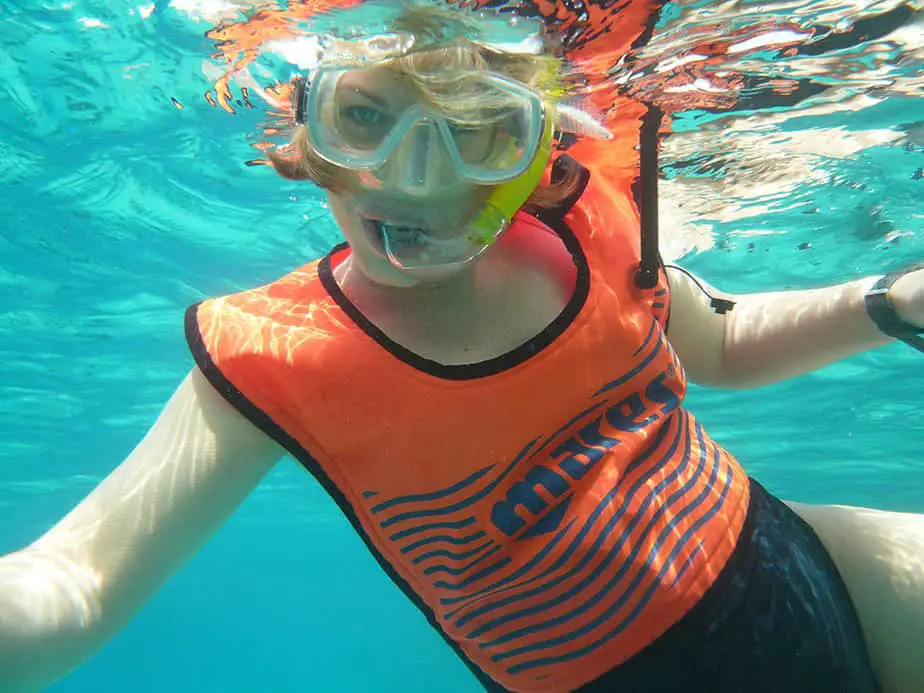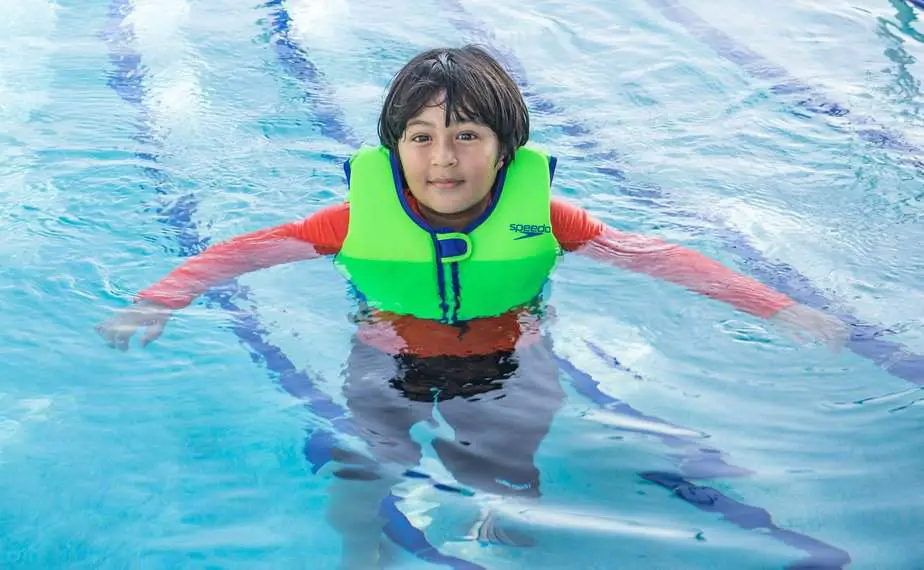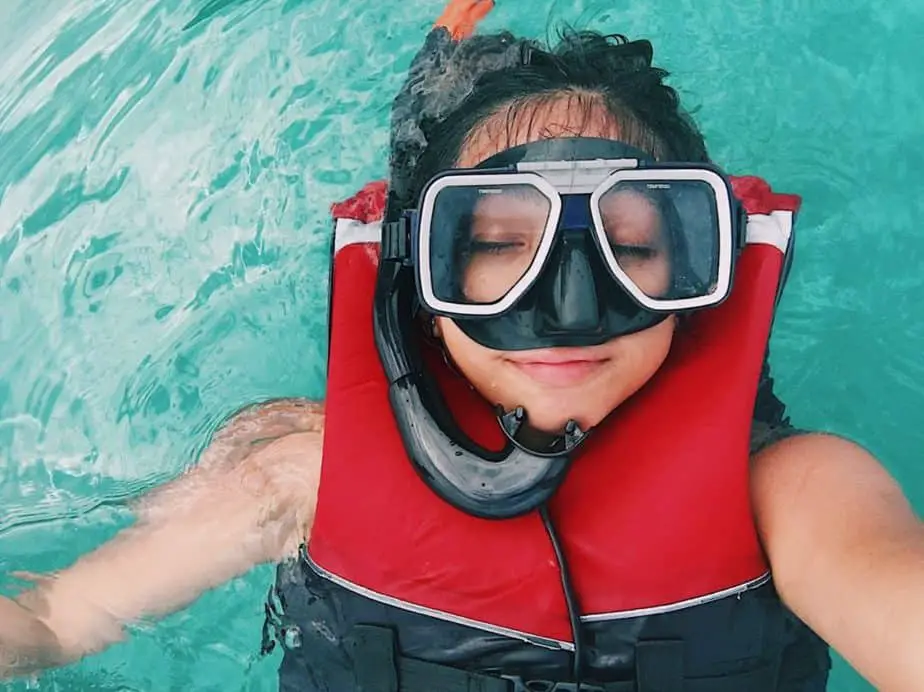So you’re just getting started with snorkeling and you’ve got yourself a mask, snorkel, and a pair of fins. Nice, you got the basics covered. But after jumping enthusiastically in the water and snorkeling for a few minutes, slowly but surely it starts to happen. You notice that you’re starting to get really tired!
You only got brief glimpses of the underwater flora and fauna before your snorkeling session was cut short due to fatigue. If only you could just stay afloat for as long as you want! And with the help of snorkel flotation devices, you can.
What are Snorkel Flotation Devices?
Snorkel flotation devices are a type of buoyancy aid or personal flotation device (PFD) that can help you conserve energy and stay afloat. Beginner snorkelers should wear them to help improve their endurance and get accustomed to snorkeling without fear of drowning. Experienced snorkelers can also make good use of a snorkel flotation device to conserve energy and snorkel as long as they want.
Snorkeling buoyancy aids are relatively cheap and can provide peace of mind for non-swimmers and adults who have to supervise children. There are many flotation devices on the market, and the most popular one for snorkeling are snorkel vests. Below, we will cover each one in detail to help you decide which one is right for you.
If you’re new to snorkeling, we also recommend you read this guide.
Types of Snorkel Flotation Devices
Snorkel Vests
The most common snorkel flotation device is none other than the snorkel vest. As the name suggests, it is a vest that you wear while snorkeling and is highly recommended for non-swimmers. It is designed in a way that makes it easy for the wearer to float along the surface of the water with their face looking down. Snorkel vests typically contain no foam and are inflatable (and deflatable to allow for diving).
Thus, the user can decide how buoyant they want their vest to be by controlling how much air is put into the air pouch. Using the air nozzle, users can inflate the vest even while in the water. To improve visibility in the water, snorkel vests are usually very bright in color so that boats or other snorkelers can see it.
It is important to note that while snorkel vests can help you stay afloat, they are not considered life saving flotation devices like life jackets are (more on that below).
There are two types of snorkel vests: the horse collar style and jacket style.
Horse Collar Vest
Horse collar vests fit over the user’s head and are kept in place with numerous straps and buckles. One of the straps goes between the legs and keeps the vest from riding up against the armpits, however some find it uncomfortable around their crotch area. Also, horse collar vests don’t provide much UV protection in the back, which can lead to sunburns if sunscreen is not applied periodically.
Jacket Vest
Jacket style snorkeling vests are worn like a jacket with a zipper up front. They provide more coverage than horse collar vests. They also come in many sizes, which helps people of various heights and weights get a better fit. Furthermore, they usually come with D-rings and pockets to help you carry extra gear with you. Unfortunately, jacket vests tend to be bulkier which can be an issue when traveling.
Life Jackets
A life jacket refers to a personal flotation device that is approved by the U.S. Coast Guard (USCG) to be life saving. They may have a similar appearance to snorkel vests, but they are constructed differently and are intended for different purposes.
The most important distinction between life jackets and other snorkel flotation devices are that life jackets will keep a person’s head above the water in the event that they lose consciousness, keeping them from drowning and earning them the name “life saving” device.
You can try to snorkel in a life vest, however it is not ideal because you will be fighting against the design of the jacket which will keep your head above water. Furthermore, life jackets are very bulky and get in the way of swimming. You can get inflatable or hybrid life jackets to reduce some of the bulk and increase comfort.
Even though it seems like life jackets are not a good choice for snorkeling, if you are part of a guided tour, then you may be provided one to ensure your safety. Additionally, if safety is your number one concern and you do not mind sacrificing some comfort to stay safe in the water, then life jackets are a fantastic choice.
Flotation Belts
Ski belts or flotation belts for snorkeling are essentially buoyant foam pads that are worn around your waist. They assist snorkelers by helping them stay afloat along the surface without limiting their movements. Flotation belts are similar to regular belts but they are secured in place using a clip or a buckle. Some flotation belts can have their buoyancy adjusted by removing some foam blocks. Snorkel vests and flotation belts
Wetsuits and Fins
Full wetsuits, shorties, and neoprene tops can do more than just protect you from sunburn, cold water, and scratches or jellyfish stings. You may not know this, but wetsuits and fins are naturally very buoyant. Short fins and less buoyant than full fins, but they pack more easily. The reason for this buoyancy is due to the gas particles that are trapped between neoprene fibres which are constantly trying to rise above the water.
However, snorkeling wetsuits provide less buoyancy than the other types of snorkel flotation devices covered above, and this effect is most noticeable in wetsuits made entirely with neoprene. If you struggle to stay afloat, don’t rely on a wetsuit to keep you at the surface without some effort on your part. For experienced snorkelers, the buoyancy provided by wetsuits is enough for them to conserve a lot of energy and snorkel for longer.
Inflatable Noodles/Pool Noodles
Next, inflatable noodles or pool noodles can be useful tools to help a new snorkeler improve their skills by increasing their stability. There are a few ways this can happen. First, you can use them to help you catch your breath when you’re tired, or if you need to surface and clean your mask without having to worry about staying afloat. Just keep a pool noodle beneath your armpits to add to your natural buoyancy.
While inflatable noodles seem like a kid’s toy, they are just as useful for adults as for children. They can also be easily passed around between children or family members as needed. With that said, pool noodles should only be used under adult supervision. After all, if it can be easily passed around, then it is possible for it to accidentally slip out from under a child. If you or your children are not strong swimmers, we recommend you use a life jacket, snorkel vest, or flotation belt instead.
Lastly, inflatable noodles are easy to pack into your bags for travel since they do not take up much space.
Frequently Asked Questions
Which Snorkel Flotation Device Should I Use?
For the most enjoyable snorkeling experience, we recommend wearing a snorkel vest. Snorkel vests can be easily inflated or deflated even while in the water, which gives you the flexibility of diving underwater if you want to. If you get the jacket style vest, it covers a large portion of your back from the sun. Jacket vests also have the most sizing options so it will be the easiest to find one that fits you. The largest snorkel vests can support over 150 pounds. The biggest concern is if a snorkel vest rides up, then it will make it hard to snorkel.
When it comes to staying safe, life jackets provide the most buoyancy and will make you float too high, making it difficult to look underwater. Furthermore, they are very bulky and impede your movement. However, in the case of an emergency, life jackets will give you the highest chances of survival.
Flotation belts and water noodles are capable of keeping you afloat similar to the snorkel vest, however they have some downsides. First, pool noodles are not secured onto your body at all. If a strong wave comes it is very easy for it to be swept away. Inflatable noodles provide the least amount of protection in this regard. Flotation belts are secured onto you, however they do nothing to keep your face above the water if you have an emergency. It is very important to know your limits, and beginners should wear either a life jacket or snorkel vest.
Why Do I Need a PFD?
There are numerous life saving reasons why you should wear a PFD. You might feel like a weirdo wearing one, but at least you’ll be a safe weirdo (and there are some nice looking PFDs you can wear as well). Here are some of the life saving reasons why you should own a PFD:
- You are not confident in your swimming skills.
- You want to keep your children safe.
- You suffer a medical emergency in the water. E.g. Heart attack.
- You experience a muscle cramp.
- You get stung by a jellyfish and experience slight paralysis.
- A strong current sweeps you far out into the sea.
- You accidentally submerge your snorkel underwater and inhale water accidentally, causing you to panic and waste precious energy.
- If your PFD is a bright color, it can make you visible to boats and other snorkelers.
Some of the above reasons may happen unexpectedly, even if you are a strong and experienced snorkeler. That is why we recommend always snorkeling with a partner, and also wearing a snorkel flotation device just in case.
If you follow snorkeling news, sometimes you read about tragic deaths that occur which could have been easily prevented if the victims had some kind of buoyancy aid with them. Don’t let that be you or anybody you know!

What Are Some Additional Benefits of PFDs?
On a more positive note, let’s talk about some of the other benefits that a snorkel PFD can provide. A PFD such as a snorkel vest can help you conserve your energy as you tread water. While wearing one, you can spend hours in the water without needing to return to shore or the boat to rest. This can give you peace of mind and let you snorkel stress-free with no artificial time limit and the knowledge that you have backup in an emergency.
If you are on a boat tour, you can wear your own PFD that you know fits you well and is clean. In addition, some PFDs have great SPF protection and may have some insulating capabilities for cooler waters.
Can I Rely on a PFD If I Don’t Know How to Swim?
If you don’t know how to swim, the only PFD we recommend for non-swimmers are life jackets. They will keep your head above water and keep you alive in emergency situations. The other PFDs mentioned in this article are effective but are not USCG approved life saving devices. Thus, non-swimmers should only wear life jackets if they plan on going into the water. With that said, we highly recommend non-swimmers practice swimming at the pool before attempting to snorkel.
How Comfortable are PFDs?
A well-fitting PFD should be snug and comfortable. Loose fitting ones will ride up against your armpits, causing discomfort and making it difficult to snorkel. Jacket style snorkel vests have the largest selection of sizes to choose from. Horse collar snorkel vests have many straps that secure it in place, including a crotch strap which some find uncomfortable but it keeps the vest from riding up into your armpits.
Life jackets are the bulkiest and will cause you to float too high, which makes it hard to snorkel. Flotation belts can have their buoyancy adjusted, as can both types of snorkel vests. And owning your own PFD will undoubtedly feel more comfortable than wearing somebody else’s or renting one.
Can I Rent a PFD?
If you are snorkeling for the first time or you are unsure if you will be snorkeling again in the future, then you can consider renting a PFD from the local dive shop or hotel. This way, you can get a feel for what it is like to use a PFD and will help you make an informed decision if you decide to purchase one for yourself. With that said, a rented PFD may have holes, leaks, fit poorly, or can be dirty.
If you are interested in learning about flotation devices specifically for women such as buoyancy compensators used in scuba diving, then click here.


